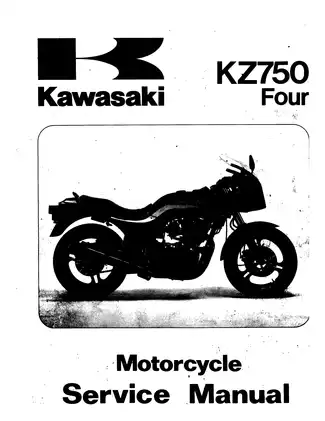Kawasaki repair manual for KZ750 Four, covers 1980-1983
Product Gallery

Sample pages from the Kawasaki repair manual for KZ750 Four, covers 1980-1983 manual

Purchase Information
1980-1983 Kawasaki KZ750 Four service manual - Technical Specifications
- Document Number / Seller:
- 26230 / Mary Jackson
- File Size:
- 67.58 MB
- File Type:
- ZIP
- Language:
- English
- Printable:
- Yes
- Estimated Download Time:
- 1.38 Minutes
- Delivery Format:
- Digital (PDF) - Instant Access
- Category:
- Bike
- Brand:
- Kawasaki
- Reviewed and Approved:
- Mar 7, 2025
Kawasaki Models and Parts Covered in this Bike Manual
KZ750 Four / Kawasaki Motorcycle & Engine Company
Complete Manual Information
Kawasaki GPZ 750 / ZX 750E & 750 Turbo Service Manual (1983-1985) - Master Repair Guide
The definitive 1983-1985 Kawasaki GPZ 750, ZX 750E, and 750 Turbo Repair Manual is the essential tool for every owner, mechanic, and technician working on these classic performance motorcycles. This comprehensive manual provides detailed, factory-authorized instructions, specifications, and troubleshooting procedures necessary to perform maintenance, complex repairs, and full engine overhauls, ensuring your Kawasaki runs with original power and precision.
Key Systems & Turbo Coverage:
This guide delivers critical service information across all major mechanical and electrical systems, including specialized components:
- Engine Top & Bottom End: Step-by-step procedures for Valve Clearance Adjustment, Cylinder Head Inspection, and complete overhaul of the Crankshaft/Transmission and Engine Lubrication System (Oil Pump).
- Turbo System (750 Turbo): Specific service and inspection guidelines for the Turbocharger System components found on the 750 Turbo models.
- Fuel & Cooling: Detailed service for the Carburetor Adjustment, Fuel Tank cleaning, and maintenance procedures for the Cooling System (Radiator, Water Pump, Coolant Replacement).
- Chassis & Controls: Comprehensive procedures for the Wheels/Tires, Brakes (Pad Replacement, Master Cylinder Overhaul), Suspension (Front Fork removal), and Steering system adjustments.
- Electrical Diagnostics: Full coverage of the Battery and Charging System, Ignition System, Electric Starter System, and detailed Wiring Diagrams for accurate fault tracing.
Table of Contents Highlights:
The manual is structured for efficient reference, ensuring fast access to required information:
- General Information: Includes Motorcycle Identification, Specifications, Torque Values, Tools, and Service Rules.
- Periodic Maintenance: Covers the Maintenance Schedule, Oil and Filter Change, and control cable adjustments.
- Engine Service: Sections dedicated to Top End, Bottom End, and Engine Removal/Installation procedures.
- Troubleshooting: Dedicated section for rapid problem identification and solutions.
Your Workshop Advantage:
"This manual is an essential resource for mechanics, technicians, and owners, providing detailed instructions on maintenance, repair, and troubleshooting procedures. Stop guessing and start servicing your Kawasaki using comprehensive diagrams and expert repair methods."
Secure the expert knowledge needed for reliable performance. Add this essential Service Manual to your cart today!
Download Instructions for Kawasaki Bike Manual
Frequently Asked Questions - Kawasaki Bike Manual
What does this Kawasaki manual cover?
This comprehensive service manual covers detailed repair procedures, maintenance schedules, troubleshooting guides, and technical specifications for Kawasaki repair manual for KZ750 Four, covers 1980-1983. It includes information for the following models: **KZ750 Four / Kawasaki Motorcycle & Engine Company**.
Is this manual suitable for beginners?
Yes, this Kawasaki manual is designed for both professional technicians and DIY enthusiasts. It includes step-by-step procedures with clear illustrations and safety guidelines for Bike maintenance and repair.
What file format will I receive?
You will receive this manual as a ZIP file (67.58 MB), which is compatible with all devices. The manual is fully searchable and printable for your convenience.
How quickly can I access the manual after purchase?
You'll receive instant access to your Kawasaki Bike manual immediately after payment completion. The download link is valid for 3 days, with lifetime re-download guarantee.
Can I print specific sections of the manual?
Absolutely! This digital manual allows you to print any section you need, from individual pages to complete chapters, making it perfect for workshop use.
Customer Reviews and Feedback
Read what our customers say about this Kawasaki Bike manual and share your own experience.
Add Comment
This policy contains information about your privacy. By posting, you are declaring that you understand this policy:
- Your name, rating, website address, town, country, state and comment will be publicly displayed if entered.
- Aside from the data entered into these form fields, other stored data about your comment will include:
- Your IP address (not displayed)
- The time/date of your submission (displayed)
- Your email address will not be shared. It is collected for only two reasons:
- Administrative purposes, should a need to contact you arise.
- To inform you of new comments, should you subscribe to receive notifications.
- A cookie may be set on your computer. This is used to remember your inputs. It will expire by itself.
This policy is subject to change at any time and without notice.
These terms and conditions contain rules about posting comments. By submitting a comment, you are declaring that you agree with these rules:
- Although the administrator will attempt to moderate comments, it is impossible for every comment to have been moderated at any given time.
- You acknowledge that all comments express the views and opinions of the original author and not those of the administrator.
- You agree not to post any material which is knowingly false, obscene, hateful, threatening, harassing or invasive of a person's privacy.
- The administrator has the right to edit, move or remove any comment for any reason and without notice.
Failure to comply with these rules may result in being banned from submitting further comments.
These terms and conditions are subject to change at any time and without notice.
Comments (5)